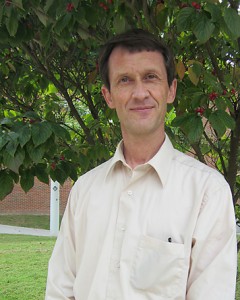Albrecht von Arnim

ADDRESS
Address Lab
Phone
Phone lab
Research Areas
- Biochemistry
- Molecular Biology
- Plant Biology
- Computational Biology
- Genetics
- Genomics
- Bioinformatics
Albrecht von Arnim
Professor, BCMB
Education
Ph.D. University of East Anglia (UK)
Research Statement
Keywords: Regulation of protein synthesis (mRNA translation)
Gene expression encompasses a complex panoply of molecular and biochemical processes whereby organisms convert the heritable information stored in the genome into molecules, cells and beyond. RNA is central to gene expression. The regulation of protein synthesis (translation) on the ribosome in particular remains incompletely understood, although translational control affords a rapid and reversible layer of control that amplifies changes in gene activity at the level of transcription. How do plants utilize translational control to adapt to changes in the environment? How does translational control contribute to plant development? These are some of the overarching questions that guide the research in our lab. We use the reference plant Arabidopsis thaliana because of the excellent genetic resources available in this species. In recent years, discoveries in our lab and elsewhere have opened the door to better understand the molecular signaling pathways that control translation in response to cues internal or external to the cell. We utilize a multi-pronged approach, combining genome-wide assays of translational efficiency with genetic analysis of Arabidopsis mutants, reporter gene expression assays and bioinformatic analysis. Leveraging the outstanding local expertise in computational biology, we are also pursuing mathematical models that illuminate these complex events. Our work has exemplified how generic translation initiation factors can contribute to the sequence-specific regulation of translational efficiency. It has highlighted that many eukaryotic mRNAs engage the ribosome itself to regulate translation through so-called upstream open reading frames. We also elaborated how the circadian clock cooperates with external signals to orchestrate the translatome over the course of the day-night cycle. Experiments such as these are revealing systematically which mRNAs are bundled together into regulons of translational control. This work helps us to understand how plants adapt to their environment and leads to novel ways to manipulate gene expression for biotechnological applications.
Selected Publications
Urquidi Camacho, R.A., Lokdarshi, A., and von Arnim, A.G. (2020). Translational Gene Regulation in Plants: A Green New Deal. WIRES RNA May 4:e1597.
Lokdarshi, A., Morgan, P.W., Franks M., Emert Z., Emanuel, C., von Arnim, A.G. (2020). Light dependent activation of the GCN2 kinase under cold and salt stress is mediated by the photosynthetic status of the chloroplast. Frontiers in Plant Science 11:431.
Lokdarshi, A., Guan J., Urquidi Camacho, R.A., Cho, S.K., Morgan, P., Leonard, M., Shimono, M., Day B., von Arnim, A.G. 2020. Light activates the translational regulatory GCN2 kinase via reactive oxygen species emanating from the chloroplast. Plant Cell 32:1161-1178.
Lokdarshi, A., Papdi, C. Pettkó-Szandtner, A., Dorokhov, S., Scheres, B., Magyar, Z., von Arnim, A.G., Bogre, L., Horvath, B.M. 2019. The ErbB-3 BINDING PROTEIN 1, EBP1 Regulates the Capacity for Protein Translation and Counteracts RETINOBLASTOMA RELATED to Maintain the Root Meristem. Plant Physiology 182:919-932.
Enganti R, Cho SK, Toperzer JD, Urquidi-Camacho RA, Cakir OS, Ray AP, Abraham PE, Hettich RL, and von Arnim AG 2018. Phosphorylation of Ribosomal Protein RPS6 Integrates Light Signals and Circadian Clock Signals. Frontiers in Plant Science 8:2210.
Mills SC, Enganti R, and von Arnim AG 2018. What makes ribosomes tick? RNA Biology 15:44-54.
von Arnim AG and Missra A 2017. Graduate Training at the Interface of Computational and Experimental Biology – An Outcome Report from a Partnership of Volunteers between a University and a National Laboratory. CBE Life Science Education 16, pii: ar61.
Missra A, Ernest B, Lohoff T, Jia Q, Satterlee J, Ke K, and von Arnim AG 2015. The circadian clock modulates global daily cycles of mRNA ribosome loading. Plant Cell 27: 2582-2599.